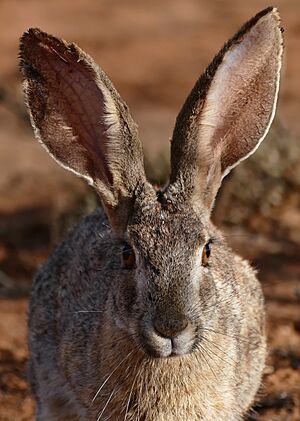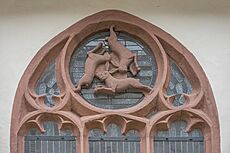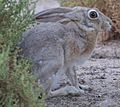Hare facts for kids
Quick facts for kids Hares |
|
|---|---|
 |
|
| Scrub hare (Lepus saxatilis) | |
| Scientific classification |
|
| Kingdom: | Animalia |
| Phylum: | Chordata |
| Class: | Mammalia |
| Order: | Lagomorpha |
| Family: | Leporidae |
| Genus: | Lepus Linnaeus, 1758 |
| Type species | |
| Lepus timidus Linnaeus, 1758
|
|
| Species | |
|
See text |
|
Hares and jackrabbits are furry mammals. They belong to a group of animals called Lepus. Hares are herbivores, meaning they eat plants. They usually live alone or sometimes in pairs.
Hares don't live in burrows like some rabbits. Instead, they make a shallow nest on the ground called a "form". Baby hares are called "leverets". They are born with fur and open eyes. This means they can take care of themselves very soon after birth.
Hares are known for being very fast runners. They have long, strong back legs. Their big ears help them hear well and also release body heat. You can find different kinds of hares in Africa, Europe, Asia, and North America.
It's important to know that hares are different from rabbits. Hares are considered "true hares." Rabbits belong to the same family but are a different group. Some animals are called "hares" but are actually rabbits, like the Belgian hare. And some animals called "jackrabbits" are actually hares!
Contents
Amazing Hare Abilities
Hares are super speedy animals. They can run up to 80 kilometers per hour (about 50 miles per hour) over short distances! The European hare can keep running at about 56 kilometers per hour (35 miles per hour) for longer times.
The five types of jackrabbits in North America are also very fast. They can run up to 64 kilometers per hour (40 miles per hour) for a long time. They can also jump really far, up to 3 meters (10 feet) in one leap!
Normally, hares are shy. But in spring, the European brown hare acts differently. You might see them chasing each other during the day. This is often male hares (called bucks) competing to show who is strongest for breeding. During this time, hares might even "box" each other, hitting with their paws. This is where the saying "mad as a March hare" comes from!
Hares, like all animals in their family, have special skulls. Their skulls can move slightly, which is unique among mammals.
Hares vs. Rabbits
Hares and rabbits are often confused, but they have some key differences:
- Hares are generally bigger than rabbits.
- Hares have longer ears and black marks on their fur.
- Hares have 48 chromosomes, while rabbits have 44.
- Hares have not been tamed by humans. Many rabbits, however, are raised for food or kept as pets.
Another big difference is where they live and how their babies are born.
- Some rabbits live and have babies underground in burrows. Many burrows together form a "warren."
- Hares and some other rabbits live and have babies in simple nests on the ground called "forms."
- Hares usually do not live in groups.
Baby hares are born with fur and open eyes. They can move around and take care of themselves soon after birth. This is called being "precocial." Baby rabbits, on the other hand, are born blind and without fur. They need more care from their parents at first. This is called being "altricial."
What Hares Eat
Hares are herbivores, so they eat plants. They have a special way of digesting their food.
- Food that is easy to digest goes through their system normally. The waste comes out as regular droppings.
- For tougher plant fibers, hares have a unique trick. Like all animals in their group, they ferment the fiber in a part of their gut called the cecum.
- Then, they produce special soft droppings called cecotropes. Hares eat these cecotropes again! This practice is called "refection."
- Eating the cecotropes a second time helps them get all the nutrients from the tough plant material.
Types of Hares
There are many different kinds of hares around the world. They are all part of the Lepus genus. Here are some examples:
- Antelope jackrabbit
- Snowshoe hare
- Arctic hare
- Mountain hare
- Black jackrabbit
- European hare
- African savanna hare
- Indian hare
- Chinese hare
- Yarkand hare
- Black-tailed jackrabbit
- Cape hare
- White-tailed jackrabbit
Hares and People
Hares have been part of human culture for a long time.
Hares as Food
Hares and rabbits are found in many places and reproduce quickly. This means they are often hunted for food. They are a common source of protein around the world. Hares can be cooked in many ways, like roasting or frying.
For example, Hasenpfeffer is a traditional German stew made from hare or rabbit. In Greece and Cyprus, people enjoy Lagos stifado, which is a hare stew with onions and spices. Hare meat is also a popular dish in Malta.
Taming Hares
Unlike some rabbits, hares have never been truly domesticated as pets. However, people have interacted with hares for thousands of years:
- A European brown hare was found buried with an older woman in Hungary a very long time ago (around 4500 BC).
- In Sweden, hare bones were found in a grave from about 3000 BC.
- In ancient China (around 3000 BC), people tamed a type of hare called the Tolai hare. They even fed them grains like millet.
Hares in Stories and Art
Hares appear in many stories and legends from different cultures.
- In African folk tales, the hare is often a clever trickster. Some of these stories became the basis for the Br'er Rabbit tales in America.
- In English folklore, the saying "as mad as a March hare" comes from the hare's wild behavior in spring. There are also legends about white hares being witches or spirits.
- The group of stars called Lepus is named after the hare.
Long ago, the hare was seen as a special animal connected to the Greek gods Aphrodite and Eros, who were related to love. Giving a live hare as a gift was a sign of love. In old European stories about witchcraft, hares were sometimes thought to be witches' helpers or even witches who had changed into hares.
Today, some popular stories link the hare to the Easter Bunny. This idea is quite new and not based on ancient traditions. In Europe, the hare often represents being swift and timid (shy). This is why the Mountain hare was once called Lepus timidus, meaning "timid hare."
Three Hares Symbol
There is a famous symbol of three hares chasing each other in a circle. Each hare seems to have two ears, but there are only three ears in total! Each ear is shared by two hares. This symbol has been found in many places, from churches in England to sites along the Silk Road in China, the Middle East, and Europe. It has been used in Christian, Jewish, Islamic, and Buddhist art for over 1,400 years.
Hare Place Names
Sometimes, places are named after hares because these animals were often seen there. For example, in Scotland, there's a place called "Murchland." Murchen is an old Scottish word for a hare.
Images for kids
-
A European hare (above) and a mountain hare
-
The skeleton of an Alaskan hare at the Museum of Osteology
See also
 In Spanish: Liebres para niños
In Spanish: Liebres para niños







